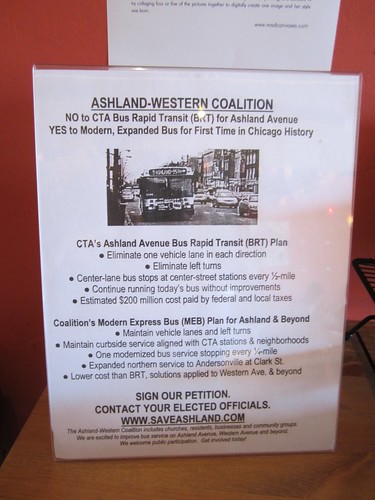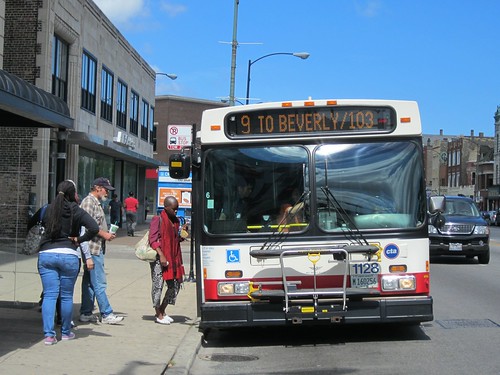Here's a flyer from the anti-bus rapid transit group the Ashland-Western Coalition, which I came across today at a café on Ashland Avenue in the East Village. The AWC is a consortium of business and community groups on the Near West Side, led by Roger Romanelli, executive director of the Randolph/Fulton Market Association. Let’s take a look at some of the information the group is putting out about the CTA’s plan to create fast reliable BRT service on Ashland.
At the top of the flyer, the AWC calls for “Modern, expanded bus [service] for first time in Chicago history.” OK, other than the fact that the Ashland bus was “modern” when it was first introduced decades ago, we’re on the same page here. By repurposing car lanes to create dedicated bus lanes, Chicago will be following the lead of dozens of forward-thinking cities around the world, from Paris to Bogota to Seoul to New York.
The flyer then lists some of the attributes of the CTA’s plan. Correct, BRT will eliminate one vehicle lane in each direction and most left turns, and it will feature “center-lane bus stops at center-streets stations every 1/2-mile.” And unlike another flyer posted on the coalition’s recently updated, but still anonymous, website, which uses the distance between BRT stops as a scare tactic, this one acknowledges that curbside, local service would be retained.
This flyer states the estimated the cost of BRT as $200 million, which is inaccurate, whether it's referring to the first 5.5-mile phase or the entire project. The CTA has estimated the first phase, between 31st and Cortland, will cost $116 million, including purchasing new buses with left-side doors. The rest of the 16-mile corridor will cost about $10 million per mile for the street improvements and stations alone, so the entire 16-mile route will come to roughly $231 million, including the first batch of buses and excluding any additional bus purchases.
The flyer suggests that the cost of BRT is unreasonable, but it’s chicken feed compared to the $475 million Circle Interchange Expansion, which is sure to lower property values on the Near West Side. I don’t recall Romanelli speaking out against that project in his district.
Meanwhile, the flyer claims that the coalition’s “Modern Express Bus” alternative proposal would be cheaper than BRT, although that’s not necessarily the case. The proposal calls for purchasing buses with front and rear entrances, plus heated bus shelters with security cameras at every stop. There would be almost three times as many MEB stops as BRT stations, plus the coalition wants to expand service 2.3 miles north from Irving Park Road to Clark Street. Onboard “bus marshals” would be hired, and there would be a variety of other bells and whistles. All these things aren’t free, but the coalition hasn’t provided a cost estimate. It’s entirely possible MEB would cost more than BRT.
The flyer states that MEB would feature “one modernized bus service stopping every 1/4-mile.” That might have actually been a sensible way to speed up the Ashland bus somewhat, if it wasn’t for the fact that there’s already political will to create BRT service that, at 15.9 mph during peak hours, including stops, will be comparable in speed to driving. And the MEB service wouldn’t actually only stop every quarter mile, which would eliminate 50 percent of stops. As outlined in the coalition’s “Executive Summary,” MEB would make additional stops at train stations, schools, hospitals, social services and churches, so it would only eliminate 30 percent of the stops.
The old #X9 Ashland Express buses, which stopped every half mile, eliminated 75 percent of stops but still crawled along at 10.3 mph, barely faster than the 8.7 mph locals, because it had no dedicated lane and got stuck behind the glut of private cars. Since MEB would make almost three times as many stops as the X9, it would probably be even slower but, understandably, the coalition hasn’t provided a speed estimate. That’s not “modernized bus service,” that’s a 20th Century solution to a 21st Century problem.
“We are excited to improve bus service on Ashland Avenue, Western Avenue and beyond,” the flyer promises, although it seems highly unlikely the coalition would continue to lobby for changes to bus service if the CTA dropped its BRT plan. If the AWC wants to oppose real improvements to Ashland bus service because they erroneously believe the removal of travel lanes and left turns will cause Carmaggedon, that’s their prerogative. But putting out flyers and other materials claiming MEB would be lower cost than BRT, and anywhere near as effective, when there’s no evidence to back up those claims, is deceptive. If you’re going to fight, fight fair.






